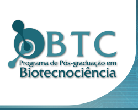Banca de DEFESA: ISABELLA MARTINS LOURENÇO
Uma banca de DEFESA de DOUTORADO foi cadastrada pelo programa.DISCENTE : ISABELLA MARTINS LOURENÇO
DATA : 26/06/2024
HORA: 13:00
LOCAL: Auditório 801 no 8º andar do Bloco B da Universidade Federal do ABC
TÍTULO:
SYNTHESIS AND CHARACTERIZATION OF NANOPARTICLES CONTAINING NITRIC OXIDE DONOR FOR BIOMEDICAL AND AGRICULTURAL APPLICATIONS
PÁGINAS: 100
RESUMO:
Nanotechnology, being an extremely multidisciplinary field of science, has received great attention for benefiting several areas of knowledge. Zinc oxide nanoparticles (ZnO NPs), for example, have been widely used and demonstrate a broad perspective for the biomedical sector, especially because of their antibacterial activity. In agriculture, ZnO NPs play an important role as a nanofertilizer and nutrient for several plants. Not less important, nitric oxide (NO) is a free radical that is present in several biological processes in mammalian cells acting in different processes such as vasodilation and skin healing and in plant cells, acting as an important factor of protection, communication and signaling of metabolic processes that mediate growth and mitigation of biotic and abiotic stresses. However, NO has a very short half-life, which makes its application less viable. Therefore, to enable the therapeutic effect of NO, a type of NO donor known as S-nitrosothiols (RSNOs) was used, in which S-nitrosoglutathione (GSNO) is present. There is significant interest in developing materials that can sustainably transport and release ZnO NPs as well as NO, as these can be used in both agricultural and biomedical applications. Therefore, the present study provided the synthesis and characterization of ZnO NPs, as well as GSNO and the incorporation of these materials in Pluronic F-127 (PL) hydrogels, evaluating their possible potential in biomedical and agricultural applications.The ZnO NPs synthesized by hydrothermal synthesis showed 118 ± 43 nm in the solid state and proved to be stable nanoparticles at physiological pH. The GSNO incorporated into the ZnO NPs showed sustained release for a period of 12 h, in addition to having demonstrated a synergistic effect of GSNO-ZnO NPs against the bacteria Staphylococcus aureus and Staphylococcus epidermidis from concentrations of 0.1 µg/mL in the activity tests antimicrobial. Next, ZnO NPs, GSNO and GSNO-ZnO NPs incorporated into PL F-127 hydrogels demonstrated the potential to carry and contribute to the sustained release of GSNO over a period of 22 h. Hydrogels containing GSNO and GSNO-ZnO NPs demonstrated antibacterial activity against Staphylococcus epidermidis at concentrations of 0.1 µg/mL for GSNO-ZnO NPs and 0.2 µg/mL for GSNO. In rice plants (Oryza sativa) it was observed that the application of ZnO NPs and GSNO can potentially contribute to mitigate possible effects caused by abiotic stress such as temperature variation, water and nutrient deficit, helping to minimize negative effects on metabolism of the plant. Likewise, the combination of the two materials (GSNO-ZnO NPs) helped to increase the rate of photosynthetic pigments such as chlorophyll A, chlorophyll B and carotenoids in relation to their control groups. Due to the results obtained in the present work, there is a great possibility that ZnO NPs as well as GSNO-ZnO NPs find different applications in the biomedical sector and in agriculture.
MEMBROS DA BANCA:
Presidente - Interno ao Programa - 1844792 - AMEDEA BAROZZI SEABRA
Membro Titular - Examinador(a) Interno ao Programa - 1831780 - DANILO DA CRUZ CENTENO
Membro Titular - Examinador(a) Interno ao Programa - 1912347 - NATHALIA DE SETTA COSTA
Membro Titular - Examinador(a) Externo à Instituição - Olga Rubilar Araneda
Membro Titular - Examinador(a) Externo à Instituição - CAMILA NEVES LANGE
Membro Suplente - Examinador(a) Externo à Instituição - ROBERTA ALBINO DOS REIS - UFABC
Membro Suplente - Examinador(a) Externo à Instituição - GONZALO RODRIGO TORTELLA FUENTES




